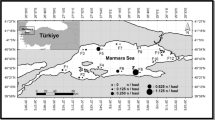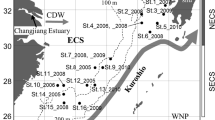Abstract
It is important to know the characteristics of migration pattern and vital rates of juveniles to understand the early life history and its effect on the population dynamics of fishes. The relationship between growth and migration pattern of juvenile temperate seabass Lateolabrax japonicus in the Yura River estuary was examined by combination of stable carbon isotope ratio (δ13C) and otolith microstructure. Gut fullness indices were also examined to know the feeding condition of juveniles. δ13C values of seabass juveniles in the lower estuary and surf zone (LES) were enriched, while those in freshwater zone (FW) were depleted, consistent with δ13C differences in prey items. The back-calculated growth rates of juveniles in FW were significantly lower than those of juveniles that resided in the LES from 50 days to 90 days old, implying that juveniles with poor growth ascended the river while those with better growth remained in the LES. However, the growth rates of the juveniles, which resided in FW for more than 1 month, caught up with and even overtook those of juveniles in LES within 1 month after ascended the river. The higher water temperature and better feeding conditions would contribute to better growth rates of juveniles in FW than those in LES.








Similar content being viewed by others
References
Beck MW, Heck KL, Able KW, Childers DL, Eggleston DB, Gillanders BM, Halpern B, Hays CG, Hoshino K, Minello TJ, Orth RJ, Sheridan PF, Weinstein MR (2001) The identification, conservation, and management of estuarine and marine nurseries for fish and invertebrates. Bioscience 51:633–641
Bujold V, Cunjak RA, Dietrich JP, Courtemanche DA (2004) Drifters versus residents: assessing size and age differences in Atlantic salmon (Salmo salar) fry. Can J Fish Aquat Sci 61:273–282
Campana SE (1990) How reliable are growth back-calculations based on otoliths? Can J Fish Aquat Sci 47:2219–2227
Campana SE (2001) Accuracy, precision and quality control in age determination, including a review of the use and abuse of age validation methods. J Fish Biol 59:197–242
Chapman BB, Hulthén K, Brodersen J, Nilsson PA, Skov C, Hansson LA, Brönmark C (2012) Partial migration in fishes: causes and consequences. J Fish Biol 81:456–478
Franco A, Fiorin R, Zucchetta M, Torricelli P, Franzoi P (2010) Flounder growth and production as indicators of the nursery value of marsh habitats in a Mediterranean lagoon. J Sea Res 64:457–464
Fuji T, Kasai A, Suzuki KW, Ueno M, Yamashita Y (2010) Freshwater migration and feeding habits of juvenile temperate seabass Lateolabrax japonicus in the stratified Yura River estuary, the Sea of Japan. Fish Sci 76:643–652
Fuji T, Kasai A, Suzuki KW, Ueno M, Yamashita Y (2011) Migration ecology of juvenile temperate seabass Lateolabrax japonicus: a carbon stable-isotope approach. J Fish Biol 78:2010–2025
Fujii T, Noguch M (1996) Feeding and growth of Japanese flounder (Paralichthys olivaceus) in the nursery ground. In: Watanabe Y, Yamashita Y, Oozeki Y (eds) Survival strategy in early life stages of marine resources. A.A.B.alkema, Rotterdam, pp 141–151
Herzka SZ (2005) Assessing connectivity of estuarine fishes based on stable isotope ratio analysis. Estuar Coast Shelf Sci 64:58–69
Hibino M, Ohta T, Isoda T, Nakayama K, Tanaka M (2007) Distribution of Japanese temperate seabass, Lateolabrax japonicus, eggs and pelagic larvae in Ariake Bay. Ichthyol Res 54:367–373
Hirata M (1967) Artificial fertilization and rearing of Japanese seaperch larvae. Rep Kumamoto Pref Fish Exp St 41:349–354
Hobson AK (1999) Tracing origins and migration of wildlife using stable isotopes: a review. Oecologia 120:314–326
Houde ED (1989) Subtleties and episodes in the early life of fishes. J Fish Biol 35:29–38
Ichthyological Society of Japan (2003) Guidelines for the use of fishes in research. The Ichthyological Society of Japan, Japan, http://www.fish-isj.jp/english/guidelines.html
Islam MS, Tanaka M (2005) Nutritional condition, starvation status and growth of early juvenile Japanese sea bass (Lateolabrax japonicus) related to prey distribution and feeding in the nursery ground. J Exp Mar Biol Ecol 323:172–183
Islam MS, Ueno M, Yamashita Y (2009) Otolith microstructure of Japanese seabass larvae and juveniles: interpretation and utility for ageing. J Appl Ichthyol 25:423–427
Islam MS, Ueno M, Yamashita Y (2010) Growth-dependent survival mechanisms during the early life of a temperate seabass (Lateolabrax japonicus): field test of the ‘growth–mortality’ hypothesis. Fish Oceanogr 19:230–242
Islam MS, Yamashita Y, Tanaka M (2011) A review on the early life history and ecology of Japanese sea bass and implication for recruitment. Environ Biol Fish 91:389–405
Jonsson B, Jonsson N (1993) Partial migration: niche shift versus sexual maturation in fishes. Rev Fish Biol Fish 3:348–365
Juanes F (2007) Role of habitat in mediating mortality during the post-settlement transition phase of temperate marine fishes. J Fish Biol 70:661–677
Kasai A, Kurikawa Y, Ueno M, Robert D, Yamashita Y (2010) Salt-wedge intrusion of seawater and its implication for phytoplankton dynamics in the Yura Estuary, Japan. Estuar Coast Shelf Sci 86:408–414
Kerr LA, Secor DH, Piccoli PM (2009) Partial migration of fishes as exemplified by the estuarine-dependent white perch. Fisheries 34:114–123
Kraus RT, Secor DH (2004) Dynamics of white perch Morone americana population contingents in the Patuxent River estuary, Maryland, USA. Mar Ecol Prog Ser 279:247–259
Li HW, Brocksen RW (1977) Approaches to the analysis of energetic costs of intraspecific competition for space by rainbow trout (Salmo gairdneri). J Fish Biol 11:329–341
Matsumiya Y, Mitani T, Tanaka M (1982) Changes in distribution pattern and condition coefficient of the juvenile Japanese sea bass with the Chikugo River ascending. Nippon Suisan Gakkaishi 48:129–138
Olsson IC, Greenberg LA, Bergman E, Wysujack K (2006) Environmentally induced migration: the importance of food. Ecol Lett 9:645–651
Ohta T (2004) Ecological studies on the river ascending migration of Japanese sea bass Lateolabrax japonicus in Ariake Bay, on the basis of otolith information. PhD Thesis, Kyoto University, Kyoto
Shoji J, Tanaka M (2007) Density-dependence in post-recruit Japanese seaperch Lateolabrax japonicus in the Chikugo River, Japan. Mar Ecol Prog Ser 334:255–262
Sirois P, Lecomte F, Dodson JJ (1998) An otolith-based back-calculation method to account for time-varying growth rate in rainbow smelt (Osmerus mordax) larvae. Can J Fish Aquat Sci 55:2662–2671
Suzuki KW, Kasai A, Nakayama K, Tanaka M (2005) Differential isotopic enrichment and half-life among tissues in Japanese temperate bass Lateolabrax japonicus juveniles: implications for analyzing migration. Can J Fish Aquat Sci 62:671–678
Suzuki KW, Kasai A, Ohta T, Nakayama K, Tanaka M (2008) Migration of Japanese temperate bass Lateolabrax japonicus juveniles within the Chikugo River estuary revealed by δ13C analysis. Mar Ecol Prog Ser 358:245–256
Tanaka M, Matsumiya Y (1982) Early life history of Lateolabrax japonicus, with special references to transitional process to juvenile stage. Saibaigiken 11:49–65
Tanaka Y, Ohkawa T, Yamashita Y, Tanaka M (2006) Geographical difference in stomach contents and feeding intensity of juvenile Japanese flounder Paralichthys olivaceus. Nippon Suisan Gakkaishi 72:50–57
Van der Veer HW, Berghahn R, Miller JM, Rijnsdorp AD (2000) Recruitment in flatfish, with special emphasis on North Atlantic species: progress made by the Flatfish Symposia. ICES J Mar Sci 57:202–215
Acknowledgments
Stable isotope ratios were analyzed at the Center for Ecological Research, Kyoto University. This study was partly supported by the Coastal Ecosystem Complex Project of the Ocean Resource Use Promotion Technology Development Program, MEXT of Japan. Japanese ethical rules regarding experimental fishing were followed during this study.
Author information
Authors and Affiliations
Corresponding author
Rights and permissions
About this article
Cite this article
Fuji, T., Kasai, A., Ueno, M. et al. Growth and migration patterns of juvenile temperate seabass Lateolabrax japonicus in the Yura River estuary, Japan—combination of stable isotope ratio and otolith microstructure analyses. Environ Biol Fish 97, 1221–1232 (2014). https://doi.org/10.1007/s10641-013-0209-4
Received:
Accepted:
Published:
Issue Date:
DOI: https://doi.org/10.1007/s10641-013-0209-4




